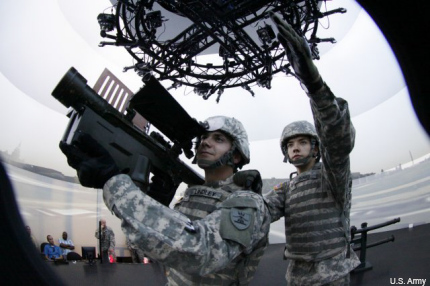Army's air defense simulator gets a big upgrade
The new Improved Moving Target Simulator fixes the glitches of its predecessor while providing more realistic scenarios.

Soldiers train in IMTS using a Man-Portable Air Defense Weapon system.
The Joint Fires Multipurpose Dome, now dubbed the Improved Moving Target Simulator, recently received significant renovations to its system, according to an Army release.
Designed to train solders in the operation of Man-Portable Air Defense Weapon systems, the original system featured a dome comprising seven computers, 84 projectors and four subwoofers. The system is capable of simulating up to 100 types of aircraft, different weather conditions and varying terrain. Two bunkers were situated in the middle of the platform, allowing up to four soldiers to train at the same time.
The upgrade to IMTS improved the graphics and fixed glitches that would occasionally shut down the entire system. The new system can also simulate new threats such as drones, as well as eight backgrounds that each have four different environmental conditions.
In terms of hardware, the IMTS will feature wireless MANPADS, fewer cameras, upgraded binoculars and fewer display panels to create a more seamless horizon. The original bunkers have since been removed to allow for more movement.
Soldiers who pick Air and Missile Defense as their specialty are required to take three weeks’ worth of classes to learn how to recognize different types of aircraft and operate MANPADS. They then have to complete 72 hours of training in the simulator, where they encounter a variety of situations. Civilian aircraft, UAVs, and friendly aircraft are all fair game.
"They have to learn to think quick, because the aircraft are moving pretty fast, depending on the scenarios,” Staff Sgt. Victor Alvarado, an instructor, said in the release. “The system is pretty advanced. We can actually modify the aircraft’s speeds and create our own scenarios and challenge them."
Working in two-person teams, the students go through the steps they have been taught: detect the target, identify if the target is an enemy, activate, lock on and tone, uncage the seeker, elevate and fire.
"The main goal of this simulation is to take everything they learn and incorporate it in here and just execute so when they go out into the operational force they're trained to do this task," Alvarado said. "It builds that confidence up that, hey, I can go out there, I can sit on a rooftop and if I needed to, shoot down an enemy aircraft.”
For the Army, the simulator represents significant savings for training. Soldiers in the specialty have to accurately take down five enemy aircraft in order to pass. With each live Stinger missile costing $120,000, the simulator saves about $600,000 per student, according to the release. The Army typically trains 300 to 400 soldiers a year in air and missile defense.



